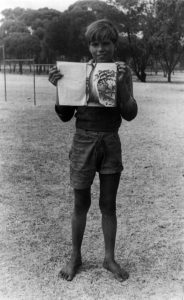In yesterday’s blog, I described the first two days of the visit of Florence Rutter and Vera Hack to Carrolup Native Settlement. Mrs Rutter’s words show clearly how highly she thought of the boys of Carrolup!
‘During the three days we spent at Carrolup we were able to watch the boys both at work and play. Speaking for myself I must relate how delighted and surprised I was with their behaviour. In every way they were exemplary – attentive, interested, appreciative, grateful, polite, unselfish, sporting and physically courageous. I hope that my own grandchildren will develop these traits as definitely as these little aboriginal boys.’ Florence Rutter, Little Black Fingers, 1951, p. 5 [Emphasis in original]
‘During the afternoon when they were drawing and painting with their crayons and paints, I noticed the boys sharing any colours with each other. These aboriginal children have the real spirit of community life – they are non-possessive and quite definitely non-acquisitive! The older boys appeared to take a pleasure in showing the younger how to do things. They are extremely intelligent and have remarkably retentive memories. Hence they learn rapidly and retain what they are taught.’ Florence Rutter, Little Black Fingers, 1950, p. 6 [Emphasis in original]
On the other hand, Florence and Vera were appalled with the living conditions in the dormitories at Carrolup:
‘… we saw the unpleasant conditions under which they lived. A large cement-floored dormitory with no floor covering of any kind; black iron bedsteads with a mattress and dark brown blanket – no pillow, sheets or quilts; no furniture of any kind. Three washbasins and one bath for 20 or more boys looked quite unused…. We saw no evidence at all in the dormitory of any night clothes for the boys or any change of clothing at all!’ Florence Rutter, Little Black Fingers, 1950, pp. 4 – 5
Florence emphasised that these conditions were not due to the Whites. In fact, she had very positive thoughts about teachers Noel and Lily White:

Ross Jones with his pastel drawing book. Photographer: Vera Hack, 1st February 1950. Noel & Lily White Collection.
‘Mr and Mrs White have brought a feeling of security to these children, and have given them a sound education during the 3.5 years they have been there. Mrs. White did what she could for the children’s welfare, but as teachers under the Education Authorities, they have no jurisdiction over the physical state of the children, that being entirely the responsibility of the superintendent and his wife who are in the employment of the Government under the Commissioner for Native Affairs.
Great credit is due to this really noble couple who, at much personal sacrifice of the common amenities of life, have remained at Carrolup, loved their pupils, and by their kind treatment of them, have brought out their wonderful gift of drawing and colouring. The standard of their school work as evidenced in the school books, compares favourably with children of the same age who have had much longer schooling.’ Florence Rutter, Little Black Fingers, 1950, p. 5
Mrs Rutter and Mrs Hack go shopping in Katanning in the morning of 2nd February. They exchange gifts with the Whites when they reach Carrolup and Mrs Hack takes some last photographs. These include a photograph of the two oldest Aboriginals on the Settlement, both around 70 years of age, who had politely requested their picture be taken. One had been a champion runner in Albany in 1905.
Prior to her and Mrs Hack’s departure at 1.30 pm, Mrs Rutter promises the boys to do all in her power to make their work known throughout the world. The boys cheer her lustily.
Today, is seventy years since Mrs Florence Rutter made her promise to the boys of Carrolup. We are taking up her mantle, having in our possession far more powerful tools to tell, and disseminate, this enthralling and inspiring Story.
This blog finishes the series relating to Mrs Rutter’s visits to Carrolup and her tour of Australia and New Zealand where she showed the Carrolup drawings. She leaves Australia on the 6th of February 1950.
In the coming months, we will blog about the exhibitions of the Carrolup drawings that Mrs Rutter held in Europe, and the public and media reaction to the Carrolup children and their artworks, as well as teachers Noel and Lily White. We will also describe events that occurred at Carrolup during this time.
You can see photos of Carrolup drawings in the Art section of our Gallery, as well as on the Colgate University Flikr pages. This link takes you to a photograph of the first of the collection, Contentment by Revel Cooper, and the rest can be accessed by continuing to click the right arrow. You can read about this latter collection in John Stanton’s blog The ‘Lost’ Florence Rutter Carrolup Collection.
Mrs Rutter with two of the trackers at Carrolup during her second visit. Photographer: Vera Hack, 2nd February 1950. Noel & Lily White Collection.


